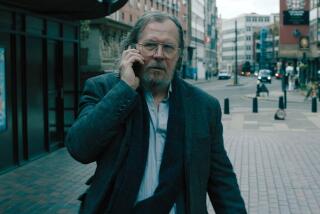How’d They Saddle Up the Novel?
A novel could be written about the process of transferring Cormac McCarthy’s prizewinning book “All the Pretty Horses” to the big screen. Creating a nonfiction account, however, is somewhat dicier, because everyone involved has a walking-on-eggshells approach to talking about it.
The “Horses” saga, which spans eight years, includes several larger-than-life characters--among them producer-directors Mike Nichols and Billy Bob Thornton, and studio heads John Calley and Harvey Weinstein--and a somewhat bumpy history. The film, jointly financed by Sony and Miramax and released by Miramax, opens today.
The film, which was directed by Thornton and stars Matt Damon and Penelope Cruz, has been receiving generally respectful, if mixed, reviews. The previously published reports of post-production disagreements between Sony Pictures and Thornton were hardly on the operatic level of such notable mega-budget films as “The Postman” or “Waterworld.” Besides, sparring between a studio and filmmakers is about as common as glazed doughnuts on a movie set.
And since Sony and Miramax split “Horse’s” modest $45-million budget, even if the film were not to succeed with audiences, it would hardly be the kind of failure that would make or break careers or engender executive upheaval.
So what’s everyone so worried about?
Except for a dictated statement from Sony Pictures’ chief Amy Pascal--”I think Billy Bob did a masterful job. He got phenomenal performances from all the actors, and delivered a picture that works very well and that everyone can be proud of”--the studio declined to discuss its relationship with Thornton. Nor would the studio discuss its sudden decision to swap the domestic release of the film with Miramax, in August, a year after the film ended shooting. (Sony will handle the foreign release.)
Stories of clashes between Sony and Thornton over the film’s length--it came down from more than four hours to around two--are dismissed by the director and Miramax’s Weinstein, though a highly placed source at Sony characterizes Thornton’s relationship with the studio as sometimes “tempestuous.” Nichols, who developed the property with Calley and tapped Thornton to direct, would not comment about removing his own name from the final credits.
Nichols had reportedly balked at one of Thornton’s earlier cuts. His press agent Leslee Dart, however, sidesteps the issue, saying that Nichols didn’t think it was right to take credit for a project from which he had divorced himself. Because Nichols wasn’t present during the film’s production, he didn’t want to take credit for it, Weinstein explains, adding: “Financially it represented a savings for Sony, so Mike was nice not to take credit.”
“Horses” is the first of several popular novels to reach the screen after a prolonged wait, including “The Shipping News,” “Memoirs of a Geisha” and “The Alienist.” Annie Proulx’s offbeat novel “The Shipping News” has been through several screenwriters and directors (including Thornton) and Sony ultimately cut the project loose; Caleb Carr’s 19th century thriller “The Alienist” has largely been abandoned; and Arthur Golden’s “Memoirs of a Geisha” is undergoing yet another rewrite (by Akiva Goldsman), with Steven Spielberg still planning to direct.
Assembling the Cast of Movie Makers
The Pulitzer Prize-winning “All the Pretty Horses” was originally purchased in 1992 by Sony for producers Calley (before he returned to the executive suite) and Nichols. The first draft of “Horses” was written by Ted Tally, an Oscar winner for “Silence of the Lambs.” The project went into limbo as Calley rejoined the ranks of studio executives at United Artists and then Sony.
Tally remained the only writer on the film. He recalls that “the final script was very similar to that [first] draft,” which was 150 pages long and very faithful to McCarthy’s 300-page novel. The major differences were that the central character, age 16 in the book, was made somewhat older and some voice-over narration was added to convey thoughts that were internalized in the novel.
When Nichols decided not to direct, “several other directors expressed interest in the project,” says Tally. While making “Primary Colors,” Nichols approached Thornton, one of the co-stars of the political comedy. Thornton was then very much in demand after his directing debut in 1996’s “Sling Blade.” Because Miramax had a three-picture deal with Thornton, the studio joined the project as co-producer and co-financier, in return for foreign distribution rights, says “Horses” producer Robert Salerno.
After discussions with Leonardo DiCaprio fell apart, the lead role went to Damon, a Miramax favorite then basking in the glow of his Oscar-winning “Good Will Hunting.” The production began shooting in February 1999 and wrapped 73 days later, on budget and one day under schedule.
Salerno downplays any friction during production, chalking it up to the normal difference in executive supervision between shooting a low-budget independent movie and a larger studio-financed project. Thornton says the only thing he fought for, and won, was the right to use his crew from his small independent movies “Sling Blade” and his as-yet-unreleased second film, “Daddy and Them.”
Also, says Salerno, “Billy Bob likes to shoot eight-hour days [12-hour days are not uncommon on studio films] because he thinks he can get a better performance out of the cast and crew with some degree of normalcy in the work schedule.” Thornton admits to having something of a “David and Goliath with his sling blade” attitude about working on a big movie, which he says came from his experience directing low-budget projects--the $1-million “Sling Blade” and the $7-million “Daddy and Them.”
Who Wields the Knife on the Final Cut?
Thornton claims he did not bicker with Sony executives during production, as has been previously reported. “They were very cooperative. I think once someone called and said Penelope Cruz’s lipstick was too dark.” Thornton says he responded with a suggestion to kiss a certain part of his anatomy, but quickly adds that it was meant as a joke and taken as such.
If the relationship hadn’t been cordial, Salerno says, Sony wouldn’t have asked Thornton to take a crack at reworking and directing “Shipping News.” Thornton has since left that project, for what he cites as personal reasons. An insider close to Thornton, however, says the problem was that he envisioned a low-budget movie and Sony had bigger plans.
Miramax eventually picked up “Shipping News.” Lasse Hallstrom (“Chocolat,” “Cider House Rules”) will direct the film this winter, starring Kevin Spacey, from an adaptation by “Chocolat” writer Robert Nelson Jacobs.
Originally, Sony had been eyeing a 1999 year-end release for “Horses,” but Salerno says Thornton, who had shot the entire 150-page script, didn’t feel he could have it ready on time.
“Billy said, ‘I’m going to shoot the entire thing, and then we’ll cut it from there,’ ” says Tally. “I was delighted, though it’s the expensive way to do it because it’s hard to know in advance what will play well and what won’t.”
In retrospect, Tally says, he wishes he had trimmed the script down before production. “It would have saved everyone a lot of trouble,” he explains. By shooting the entire script (most feature-length screenplays are 120 pages) the editing process became more arduous, since Thornton had final cut only if he delivered a two-hour film.
“It was probably a mistake for Billy Bob to show Sony his first assembly of the movie, which was almost four hours long,” says Weinstein.
That cut was never intended to represent the finished product, says Thornton, who knew he had more work ahead, which he had to fit in while appearing as an actor on three films back to back. When Sony toyed with the idea of releasing the film in the spring of 2000, Weinstein intervened.
“We all saw it as a fall/holiday release in time for awards season,” says Salerno. Sony obliged, but it was at this point that things got stickier. Thornton reportedly had a longer cut (somewhere between 2 1/2 and three hours) with which he was pleased but the studio was not.
Because Thornton couldn’t contractually have final cut on a movie that was longer than two hours, Weinstein was handed the reins. That, in part, seems to be the reason “Horses” became a Miramax Christmas release. Also, Sony had three films set for the end of the year--”Charlie’s Angels,” “Vertical Limit” and “Finding Forrester”--while Miramax had only the limited releases of “Chocolat” and the Italian film “Malena.” Plus, Sony was in the midst of a reevaluation about financing film dramas after the failure of a number of such projects in the past few years.
Thornton and Weinstein call the two-hour version of “Horses” the “best commercial cut of the film.” According to Tally, there are no scenes missing from what was shot, and all the trims were made within scenes. Thornton says he is happy with the release version, though he adds there’s a two-hour, 38-minute cut “that I don’t necessarily like better, but I like different.”
More to Read
Only good movies
Get the Indie Focus newsletter, Mark Olsen's weekly guide to the world of cinema.
You may occasionally receive promotional content from the Los Angeles Times.










